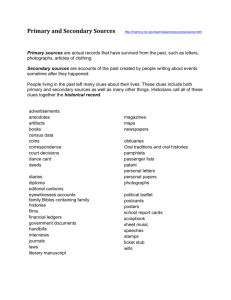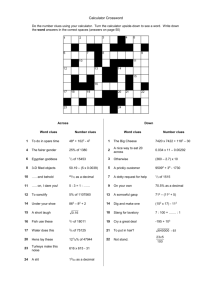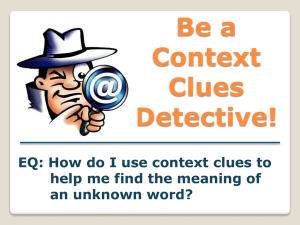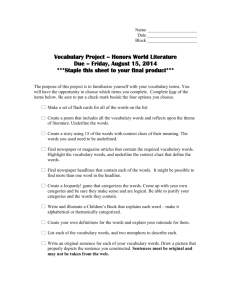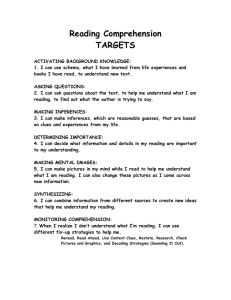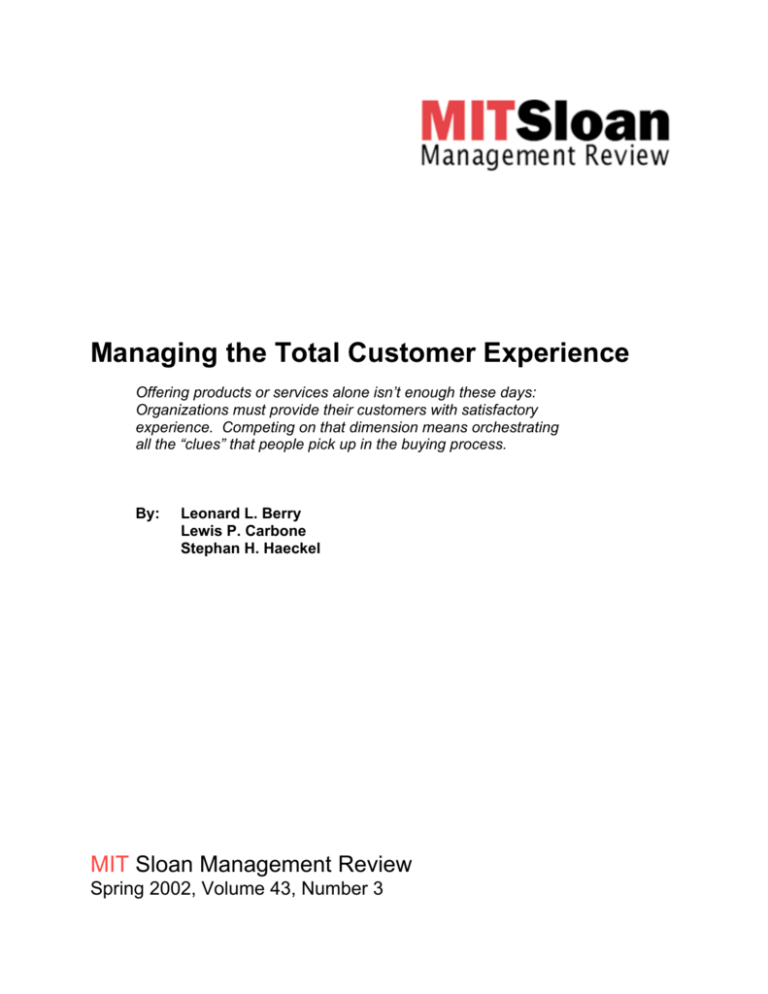
Managing the Total Customer Experience
Offering products or services alone isn’t enough these days:
Organizations must provide their customers with satisfactory
experience. Competing on that dimension means orchestrating
all the “clues” that people pick up in the buying process.
By:
Leonard L. Berry
Lewis P. Carbone
Stephan H. Haeckel
MIT Sloan Management Review
Spring 2002, Volume 43, Number 3
Managing the Total Customer Experience
In recent years, managers have become increasingly
aware of the need to create value for their customers
Recognizing the Clues
in the form of experiences. Unfortunately, they have
When we talk about clues, we don’t mean the
often proceeded as if managing experiences simply
snippets of information or bits of physical
meant providing entertainment or being engagingly
evidence that only crime-novel detectives can
creative. The issue is far more
find. In fact, the clues that make
1
complex than that.
up a customer experience are
Restaurants that put
everywhere, and they’re easily
photographs of movie stars on
discerned. Anything that can be
their walls and retailers that
perceived or sensed -- or
“A company’s first step
hang motorcycles from their
recognized by its absence -- is an
ceilings -- to give just two
experience clue. Thus the product
toward managing the total
examples -- will ultimately be
or service for sale gives off one
customer experience is
disappointed in customers’
set of clues, the physical setting
responses if they fail to make
offers more clues, and the
recognizing the clues it is
such objects part of a wellemployees -- through their
conceived, comprehensive
gestures, comments, dress and
sending to customers.”
strategy of managing the
tones of voice -- still more clues.
customer’s experience.
Each clue carries a message,
suggesting something to the
To carry out such a strategy,
customer. The composite of all
companies must gain an
the clues makes up the
understanding of the customer’s journey -- from
customer’s total experience.
the expectations they have before the
experience occurs to the assessments they are
The clues that make up a customer experience
likely to make when it’s over. Using that
fit into two categories. The first concerns the
knowledge, companies can orchestrate an
actual functioning of the good or service. Clues
integrated series of “clues” that collectively meet
relating to functionality are interpreted primarily
or exceed people’s emotional needs and
by the logical circuitry of the brain. Did the
expectations. The internalized meaning and
plumber fix the leak? Did the rental car start
value the clues take on can create a deepwhen I turned the key? A car that starts when it
seated preference for a particular experience -is supposed to provides a clue that other aspects
and thus for one company’s product or service
of functionality may also be in good working
over another’s.
order, such as the heater or the global
positioning system.
An organization’s first step toward managing the
total customer experience is recognizing the
The second category concerns the emotions and
clues it is sending to customers. Companies that
includes the smells, sounds, sights, tastes and
sense trouble -- in the form of falling customertextures of the good or service, as well as the
satisfaction scores or new competitive threats -environment in which it is offered. The feel of
would do well to consider undertaking the
leather upholstery, the sound and smell of a
focused, comprehensive management of all the
steak on the grill, the tone of voice of the person
clues that give off signals to people. Fortunately,
answering the customer-service line are all clues
specific tools are available to help organizations
that envelop the functionality of a product or
with this process. And, as we’ll show, some
service. This category of clues includes two
companies are using the tools of customertypes: “mechanics” (clues emitted by things) and
2
experience management to create a competitive
“humanics” (clues emitted by people). Such
advantage that is difficult to match.
clues tend to address emotions rather than
MIT Sloan Management Review, April 2002
1
Managing the Total Customer Experience
reason, as people consider whether to buy or
move on.
can, when used systematically, help
organizations develop this necessary skill.
It’s no doubt clear that providing the right clues
The first tool is an “experience audit” in which
about functionality is essential -- if a product is
companies get close to their customers in a
perceived as shoddy, people won’t buy it, period.
literal sense. Using stationary video cameras as
Providing a car that starts upon ignition, fixing
well as pinhole cameras hidden in a researcher’s
the faucet so that it always shuts off when the
wristwatch or clothing, organizations can
handle is turned: These are table stakes that
document a great body of actual customer
companies must have to enter the game. What’s
experiences. (Although these activities are legal,
less clear, perhaps, is that the emotional clues,
companies may wish to post signs to inform
the mechanics and humanics, are just as
customers that cameras are in use.)
important to the customer
Researchers can
experience and work
subsequently analyze hours
synergistically with functional
of tape, frame by frame,
clues. Customer value can’t be
watching facial expressions,
“Companies must manage
reduced to functionality versus
gestures and body language
price. Instead, it is composed of
in order to understand
the emotional component of
both the functional and the
customers’ emotional states
emotional benefits customers
in various situations. For
experiences with the same
receive minus the financial and
example, it is easy to monitor
the nonfinancial burdens they
the growing anxiety of a
rigor they bring to the
3
bear.
potential car buyer after she
enters a dealership. People
management of product and
The importance of sensory
in that situation behave
experience helps explain how
almost like prey in the wild:
service functionality.”
nonmonetary burdens (a
The vehicles are the bait, the
disorganized store, long lines at
surrounding offices are like
the checkout) can outweigh the
hunting stands, and the
customer’s consideration of
salesperson converges, in
price. Indeed, if the burden component of value
the customer’s eyes, almost like a hunter. It’s no
were driven strictly by price, no one would ever
wonder that so many people dread the carpay to fly first-class and Wal-Mart would have
buying experience.
vanquished Target by now. Companies that have
little or no sensitivity to the customer’s
The use of videotape alone isn’t enough to
experience and focus only on reducing their
conduct an experience audit; companies should
costs to support lower prices may actually
also conduct in-depth interviews with customers
decrease the value of their offerings.
and employees to find out how people on both
sides of a transaction feel about different aspects
To fully leverage experience as part of a
of an experience and the emotional associations
customer-value proposition, organizations must
that go along with it. Consider what such
manage the emotional component of
interviews revealed about the way customers
experiences with the same rigor they bring to the
and salespeople perceived the experience of
management of product and service functionality.
shopping for computers. Potential buyers often
The way to begin that effort is by observing
felt they were being talked down to by know-it-all
customers and talking to them about their
clerks; they much preferred being assisted in a
experiences in order to gain a deeper
hands-on, trial-and-error manner in which they
understanding of the clues they’re processing
could learn about the equipment through direct
during their encounters with the company.
experience to find what they really needed and
wanted. The salespeople, on the other hand,
Building a New Competency
explained that they felt enormous pressure to
The company’s goal, of course, is to get to the
know everything about everything -- in other
point where it is providing just the right set of
words, to develop a knowledge of the products
clues to its customers. But a competency in
that would lead them, quite naturally if
customer-experience management can’t be built
unintentionally, to condescend to customers.
overnight. Fortunately, specific tools exist that
MIT Sloan Management Review, April 2002
2
Managing the Total Customer Experience
Once the audit has been completed, the team in
charge of overhauling the customer experience
should use the results to develop an “experience
motif” that reflects the organization’s core values
and branding strategy. Captured in a few words,
the motif then serves as the North Star for all
experience-management efforts. In other words,
it acts as the unifying element for every clue in
the newly designed customer experience. One
financial institution, for example, wanted its
customers to feel “recognized, reassured and
engaged”; those terms became shorthand for the
motif. Only mechanics and humanics that
reinforced these watchwords were accepted as
part of the newly designed experience.
One might assume that emotional connections
would come naturally in any health-care setting.
But past experience of the University Hospital
emergency department in Augusta, Georgia,
illustrates how the emotional needs of customers
are often systematically overlooked -- even when
the customers are called patients.
In 1997, University Hospital was concerned
about competition from other health-care
providers as well as slowly declining customersatisfaction scores. As a result, it went through
an experience audit and implemented customerexperience management in its emergency
facility. The audit revealed that the clues coming
from the facility showed minimal recognition of
the emotional needs of patients, and even less
for the needs of their families. The hospital
subsequently developed a motif and clues that
focused on creating a reassuring, empathetic
connection between the ER facility on one hand
and patients and their family and friends on the
other.
The experience motif is the touchstone from
which clues can be developed and defined.
Mechanics can be represented graphically in
drawings, and humanics should be described in
narratives pegged to employee roles. For
example, a bank’s motif might be “create a
feeling of psychological comfort” for its
customers. A drawing of the bank’s entry that
reflected the motif would depict a message
welcoming customers rather than a notice
warning would-be robbers of video surveillance.
And the employee narrative would indicate how
tellers should greet customers to make them
comfortable before they conduct transactions.
When done thoroughly and thoughtfully, the
drawings and narratives can become a critical
part of an organization’s road map for
communicating, implementing and monitoring a
customer-experience management system.
Eventually, the task force in charge of this
project -- nurses, doctors and administrative staff -created more than 100 clues, some of which were
visible well before any prospective patient began
his or her experience at the site. The hospital
added more signs farther away in all directions;
signs reading “Hospital 3 miles” reassured people,
especially newcomers to the area, who might one
day need to obtain emergency help quickly. The
hospital also created entrances that were easy to
use. Before the audit, a giant “Emergency” sign
observable from the street directed traffic to an
easily found entrance – one that turned out to be
for ambulances only. People arriving in cars were
perpetually confused about which entrance to use
and where to park. Repositioned and reworded
signage addressed that problem. Similarly, the site
made internal signs easier to follow. Visitors no
longer had to decipher the meaning of “Triage
Station”; the sign was changed to “Care Point 1 -Reception.” And Care Point 3, the location for
pediatric emergencies, could be found in the
redesigned setting by following a popsicle icon.
Organizations that conduct a thorough audit and
then implement the necessary changes put
themselves in a superior position. Competitors
can, of course, attempt to catch up by putting in
experience management systems of their own.
And while competitors can reap some initial
benefits by doing so, they will never be able to
replicate another system in its entirety.
Meanwhile, companies that have gotten a head
start by implementing complete systems will
continue to find ways to cement their bonds with
customers by improving their overall
experiences.
The hospital also changed clues on the
humanics side. In the failed setup, a stationary
security guard sat behind an imposing desk; in
the new design, the guard became a greeter and
a roving ambassador, helping people navigate
the registration process. The facility also added a
new position that essentially added an air-traffic
controller to the ER. The person in this role
To see how such systems work in practice, let’s
follow two examples in which the customer
experience improved dramatically.
Emergency Room Connections
MIT Sloan Management Review, April 2002
3
Managing the Total Customer Experience
keeps track of patients and their progress and
updates family members in the waiting room,
who are otherwise cut off from what’s going on in
the examination rooms.
policy and a project team in Newark that handled
day-to-day implementation.
An experience audit was conducted, complete
with videotape and in-depth interviews, to
evaluate customers’ needs and desires at
specific points in the car-renting experience.
Insights from the audit led to the development of
an experience motif based on relieving customer
stress and anxiety. The motif anchored and
aligned all the experience clues subsequently
developed by the team.
Once the task force began looking at patients’
experience through the lens of an experience
management system, “a huge revelation and
transformation took place,” according to George
Ann Phillips, director of emergency services at
the hospital. No single new clue was responsible
for the change. The benefits came in the
elimination of negatives, followed by the
cumulative design and
development of emotionally
positive clues, all of which were
related to the motif. Within
“Organizations that simply
months of the implementation of
the experience management
tweak design elements or
initiatives, the facility saw a 13%
improvement in the rating of its
focus on the customer
overall quality of care and a
decline by one third in customer
experience in isolated pockets
complaints.
For example, the research
revealed that customers
were usually anxious when
they returned cars and
concerned about making
their flights. To reduce that
anxiety, Avis installed
monitors showing flight
departure times and gates
and placed them at the
door of the return facility
where customers would be
of their business will be
One example of the
likely to see them. The
transformation can be seen in
research also indicated
disappointed in the results.”
the way the morgue experience
that arriving passengers
was improved. Sounds like a
were anxious about
dismal task and maybe an
communicating with their
impossible one: What can it
offices or conducting
mean to design the morgue experience from a
business before leaving in their rental cars. Avis
customer perspective? But consider that
created a communication center for people who
normally someone simply wheeled a gurney with
needed to make calls, send faxes or plug in their
the body on it into a stark, brightly lit “storage”
laptops.
room where the family was left to stand briefly
with the deceased. Some members of the project
Another set of new clues centered on the
team decided on their own to devote part of a
location’s security guards. While continuing to
weekend to changing things. In a day’s time, the
maintain security, they began to double as
group put up curtains to create privacy,
customer-courtesy representatives, and their
disconnected harsh fluorescent lighting, brought
uniforms and workstations reflected the change.
in incandescent lamps, furnished the area with
In their new roles, they checked out cars for
chairs, and even put up a wallpaper border.
people who were part of Avis’ growing frequentVisitors to the morgue may now have an
renter express program. Customers in the
experience that makes it a little easier to deal
program could avoid going inside to deal with
with their loss and enhances how they remember
counter personnel, and the outside reps received
their time at the hospital.
coaching on actions and dialogue that would
support the experience motif.
Trying Harder -- and Succeeding
In the early 1990s, Avis Rent A Car had declining
Following the implementation of the new
customer-service scores. In 1994, Avis applied
experience design, the Avis location at Newark
experience management techniques at its
Airport won the J.D. Power award for customer
Newark International Airport location, one of its
satisfaction the next year. Within 18 months, the
largest operations. The experience design was
company’s management rolled out the
guided by a core team of eight that set broad
experience design to other key locations that
accounted for more than 65% of Avis’ business.
MIT Sloan Management Review, April 2002
4
Managing the Total Customer Experience
By 1999, Avis had moved from near the bottom
to twelfth in the Brand Keys customer-loyalty
recognition survey of more than 140 national
brands in 26 industries. In 2000 and 2001, Avis
ranked number one in the same survey.
Leonard L. Berry is the M.B. Zale Chair of
Retailing and Marketing Leadership at Texas
A&M University in College Station, Texas.
Lewis P. Carbone is president and chief
experience officer of Experience Engineering in
Minneapolis.
Stephan H. Haeckel is director of strategic
studies at the IBM Advanced Business institute
in Palisades, New York. Contact them at
lberry@cgsb.tamu.edu, lcarbone@expeng.com,
haeckel@us.ibm.com.
Competing With Experiences
Customers always have an experience -- good,
bad or indifferent -- whenever they purchase a
product or service from a company. The key is
how effectively the company manages the
experience. Organizations that simply tweak
design elements or focus on the customer
experience in isolated pockets of their business - by providing a quick hit of entertainment, for
example -- will be disappointed in the results.
Companies compete best when they combine
functional and emotional benefits in their
offerings. Emotional bonds between companies
and customers are difficult for competitors to
sever. To compete successfully in this territory, a
growing number of organizations are
systematically applying the principles and tools
of customer-experience management to
strengthen customer loyalty. Unlike many
product or service enhancements, the holistic
nature of these experiential designs makes them
very difficult for competitors to copy.
MIT Sloan Management Review, April 2002
5
Managing the Total Customer Experience
Acknowledgments
The authors acknowledge the contribution of Suzie Goan, marketing director of Experience Engineering.
Reprint TK
Copyright © Massachusetts Institute of Technology, 2002. All rights reserved.
1
Readers interested in the application of axiology (theory of value) to consumer experiences will find a
comprehensive discussion by M. Holbrook, “The Nature of Customer Value,” in R. Rust and R. Oliver,
eds., “Service Quality: New Directions in Theory and Practice” (Thousand Oaks, California: Sage, 1994).
J. Deighton describes customers as theatergoers and offers an original approach to turning performances
into experiences in “The Consumption of Performance,” Journal of Consumer Research 19 (December
1992): 362-372.
Also of interest are R. Chase and S. Dasu, “Want To Perfect Your Company’s Service? Use Behavioral
Science,” Harvard Business Review (June 2001); B.J. Pine and J. Gilmore, “The Experience Economy:
Work Is Theater and Every Business a Stage” (Boston: Harvard Business School Press, 1999); B.
Schmitt, “Experiential Marketing: How To Get Customers To Sense, Feel, Think, Act and Relate to Your
Company and Brands” (New York: Free Press, 1999); S. Haeckel, “Adaptive Enterprise: Creating and
Leading Sense-and-Respond Organizations” (Boston: Harvard Business School Press, 1999); L.L. Berry,
“Discovering the Soul of Service” (New York: Free Press, 1999); and D. Travis “Emotional Branding”
(Roseville, California: Prima Venture, 2000).
In “The Emotional Brain” (New York: Simon & Schuster, 1996), neurobiologist Joseph Ledoux provides
experimental evidence that humans have two neurologically different categories of thought: rational and
emotional. For a synthesis of research in environmental physchophysiology, see H.R. Rubin and A.J.
Owens, “Status Report: An Investigation To Determine Whether the Built Environment Affects Patients’
Medical Outcomes” (Lafayette, California: The Center for Health Design, 1996).
2
L. Carbone and S. Haeckel, “Engineering Customer Experiences,” Marketing Management 3 (winter
1994): 8-19.
3
Recent neuroscience-based research by G. Zaltman and others underscores the emotional side of value
creation. For a summary of some of this research, see G. Zaltman and K. Braun, “Mind of the Market”
(Boston: Harvard Business School Press, 1998). Also see D.B. Wolfe, “What Your Customers Can’t Say,”
American Demographics (February 1988). As Zaltman stated in 1997 at Procter & Gamble’s Future
Forces Conference in Cincinnati, Ohio, “Consumer preference and motivation are far less influenced by
the functional attributes of products and services than the subconscious sensory and emotional elements
derived by the total experience.”
For more information, please contact:
®
Experience Engineering , Inc.
7808 Creekridge Circle, Suite 225
Minneapolis, MN 55439
MIT Sloan Management Review, April 2002
(952) 942-8880
http://www.expeng.com
6
Managing the Total Customer Experience




